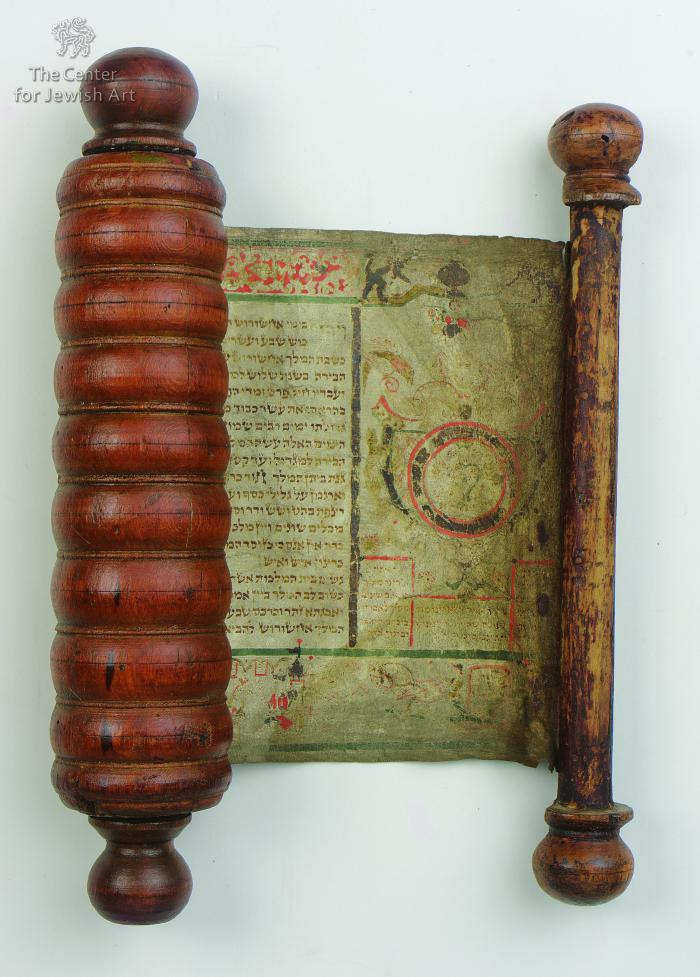Obj. ID: 37883 JML Illustrated Esther Scroll in a Wooden Case, Germany, 18th century

Dimensions of the selected details in the scroll:
- upper margins: 20 mm;
- lower margins: ca. 35 mm;
- illustrations: ca. 28 x ca. 85 mm;
- text panels together with frames: 115x95 mm;
- an average letter in the scroll: 2 mm (height).
In general, the scroll is poorly preserved.
The text and the decorations at the beginning of the scroll are barely visible. Also, some illustrations are seriously damaged.
The ink is faded or flaked off.
The parchments are crumpled, stained, and dirty.
The scroll opens with a seriously damaged decoration with a circle in its central part. It could originally be filled with a double-head eagle and an inscription in Hebrew (see: "Scribal notes"); currently, barely visible remains of them can be noticed. Below the decoration, in the lower margin, the initial benedictions in three small red-orange frames are penned. The upper margins are filled with floral ornaments in the color of parchment shown on the red-orange background. The Hebrew text of the Book of Esther is copied within rectangular panels; every column starts with an enlarged word המלך written in decorative letters. The panels are separated by columns entwined with wines standing on decorated bases. They are topped with crowns and above them are birds; above the birds, in the upper margins, there are the signs of the Zodiac in roundels. The lower margins adorn the narrative scenes from the Book of Esther enclosed in oval and decorative frames; they do not appear in chronological order:
1. The illustration is damaged and its details are barely visible. On the left is a horse with a coachman and the horse is pulling the carriage with two figures inside; it is followed by another man. Possibly the scene depicts the arrival of Esther in the king's palace (Es. 2:8).
2. On the right, the enthroned King Ahasuerus with a scepter in his hand and the queen kneeling before him are shown (possibly, this is the coronation of Esther in Es. 2:17). On the left, a feast after the coronation is depicted (Es. 2:18).
3. On the right, the enthroned King Ahasuerus and a man kneeling before him are shown, possibly this is Haman who entreats the king to issue a decree destroying the Jews (Es. 3:9). On the left, a decree is written by a scribe (Es. 3:12) and three men - the king's messengers? - are standing in front of the desk.
4. On the right, the king is drinking from a goblet and before him, three men - his servants? - are standing. On the left is Mordecai with his hands raised and tefillin on his head; possibly Mordecai in mourning is shown here (Es. 4:1-3).
5. Hatach exchanges messages between Esther and Mordecai (Es. 4:4-16).
6. On the right, Mordecai at the palace gate can be seen (Es. 5:9). On the left, the first feast of Esther is shown (Es. 5:5-8).
7. On the right, the king is handing his ring to Haman (Es. 3:10). On the left, possibly the silver is weighted for the king (Es. 3:9).
8. The scene is damaged and cannot be interpreted properly. Possibly is contains, a figure of the king with a ring, a messenger with a letter in his hand, and Mordecai.
9. On the right, the enthroned King Ahasuerus is attended by his courtiers. The king extends a scepter to Queen Esther who - with her maidservants - is shown in the center (Es. 2:9). On the left, Hatach (?) delivers Esther's message to Mordecai.
Illustrations nos. 1-6 are painted on the first membrane and the remaining two are on the second membrane. They are separated by different ornaments that are in the color of parchment shown on the red-orange background.
A wooden pull bar is stitched to the right edge of the first membrane. The manuscript is housed in a wooden case.
The Book of Esther in Hebrew preceded by the benedictions recited before the Megillah reading.
The scroll: The number of membranes is unknown.
The first membrane contains 5 columns of text, the second at least 3 columns. Each of them has 19 lines.
The text is written in Hebrew Ashkenazi stam script with tagin in brown ink on the parchment membranes that are of medium thickness, rather soft and grey.
The letter ח (Es. 1:6) is decorated with scrolled feet.
Every word המלך at the head of the column of text is enlarged and written in decorative letters.
Some letters are seriously elongated, while others are very narrow.
The ruling and pricking are invisible.
The membranes in the scroll are glued together.
The benedictions: The formulas are barely readable.
It seems that in a roundel in the opening decoration an inscription could be written. Some traces of the letters can be discerned; one of the words could be אני - "I am / my name is...".
Due to the state of preservation of the manuscript and the fact that it is housed in a case, only the first membrane and a part of the next one were opened during the research, therefore a detailed description of the scroll was not possible.
Some details in the scroll could originally be painted gold.
It is very likely the same brown ink was used for writing the text and for the drawings.
No bibliography on the scroll is available.



